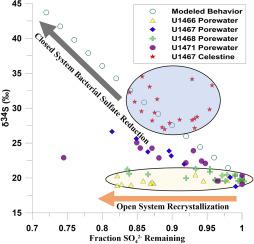Chemical Geology ( IF 3.6 ) Pub Date : 2022-08-19 , DOI: 10.1016/j.chemgeo.2022.121062 Evan W. Moore , Peter K. Swart

|
The δ34S values of porewaters, carbonate associated sulfate, and celestine were analyzed from International Ocean Discovery Program Leg 359 Sites U1466, U1467, U1468, and U1471 drilled in The Maldives. These analyses reveal a complex diagenetic history in which the nature of the porewater gradients and their δ34S values varied multiple times during deposition and subsequent diagenesis, with changes recorded in the δ34S values of carbonate associated sulfate and celestine. The δ34S values of these components as well the pore fluids have been influenced by bacterial sulfate reduction which elevates the δ34S values while the concentrations of SO42− in the interstitial porewaters are drawn down. In most instances, the δ34S values of the carbonate associated sulfate and celestine bear little resemblance to the present day porewater δ34S values or those of the contemporaneous seawater. In cases where the δ34S values of the carbonate associated sulfate are similar to those of the porewaters, it suggests that neomorphism and/or recrystallization processes are taking place at the present time. Where δ34S values of the carbonate associated sulfate are similar to the original sediment values it is likely that either little diagenesis has taken place, or that it has taken place in an environment in which the pore fluids had a δ34S value not significantly different than the original sedimentary value. The δ34S values of the celestine at Site U1467 provide a further constraint in that it indicates formation at a time in which the pore fluids had an even more positive δ34S value, and thus a lower SO42−concentration and higher Sr2+ concentrations.
中文翻译:

使用孔隙水、碳酸盐和天青石的硫同位素组成的马尔代夫再结晶和流体平流的证据
孔隙水、碳酸盐相关硫酸盐和天青石的 δ 34 S 值是从在马尔代夫钻探的国际海洋发现计划第 359 段 U1466、U1467、U1468 和 U1471 站点分析的。这些分析揭示了复杂的成岩历史,其中孔隙水梯度的性质及其 δ 34 S 值在沉积和随后的成岩过程中多次变化,其中记录了碳酸盐伴生硫酸盐和天青石的 δ 34 S 值的变化。这些组分以及孔隙流体的 δ 34 S 值已受到细菌硫酸盐还原的影响,从而提高了 δ 34 S 值,而 SO 4 2-的浓度在间隙孔隙水被抽走。在大多数情况下,碳酸盐伴生硫酸盐和天青石的δ 34 S 值与当今孔隙水或同期海水的δ 34 S 值几乎没有相似之处。如果碳酸盐伴生硫酸盐的 δ 34 S 值与孔隙水相似,则表明目前正在发生新晶型和/或重结晶过程。当碳酸盐伴生硫酸盐的 δ 34 S 值与原始沉积物值相似时,可能发生的成岩作用很少,或者发生在孔隙流体具有 δ 34的环境中S值与原始沉积值无显着差异。地点 U1467 的天青石的 δ 34 S 值提供了进一步的约束,因为它表明在孔隙流体具有更正的 δ 34 S 值的时间形成,因此 SO 4 2-浓度较低且 Sr 较高2+浓度。











































 京公网安备 11010802027423号
京公网安备 11010802027423号